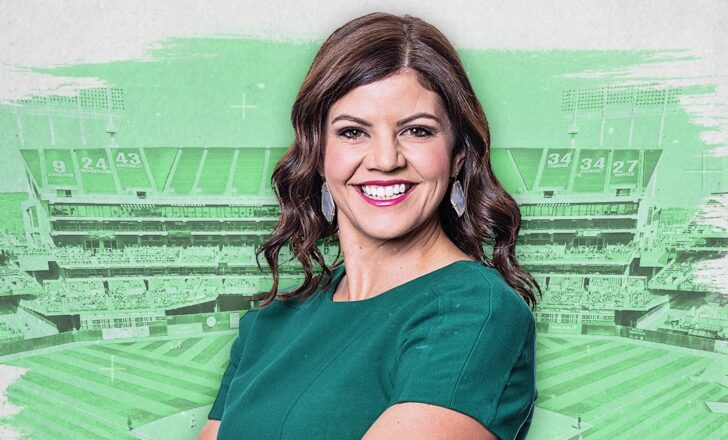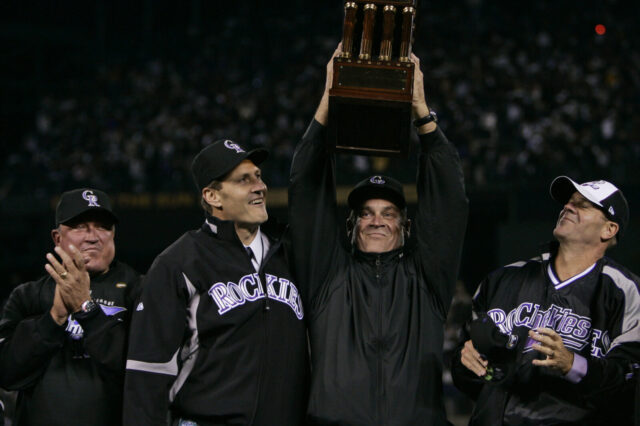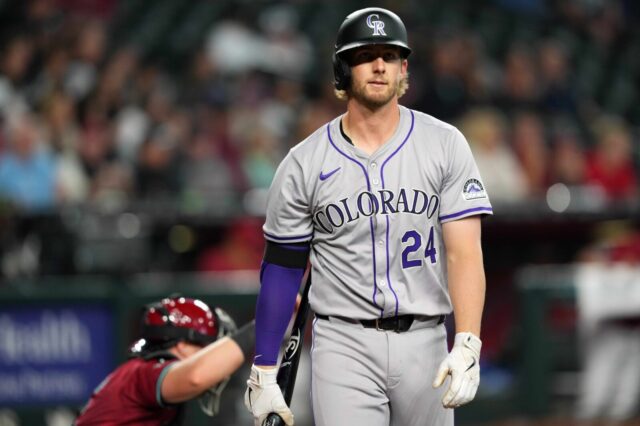Colorado’s renowned for its pioneering spirit, and one of Colorado’s own forged a brand new trail on Tuesday, as longtime Colorado Rockies broadcaster Jenny Cavnar became the first woman to take over primary play-by-play duties for a Major League Baseball team.
Cavnar joins the A’s organization this spring, as the team prepares to move from its longtime home in Oakland to glittering Las Vegas, site of the just-completed Super Bowl LVIII, and the nation’s newest sports hotbed.
Cavnar, who graduated from Smoky Hill High School in Aurora, and from Colorado State University in Fort Collins – where she also played lacrosse – has been on the Rockies’ television broadcasts for the last 12 seasons, hosting pregame and postgame programming, while also serving as Drew Goodman’s backup on play-by-play duties.
In 2018, she became the first woman in a 25 years to call a game – and her “fire up the fountains” home run call was born.
“It is a dream come true to join the broadcast team for the Oakland A’s and their rich baseball history,” Cavnar said in a statement. “Growing up the daughter of a baseball coach, I have loved the game from a young age, along with the stories, history and relationships the game provides. I’m excited to start my 18th season as a major league broadcaster with my good friend Dallas Braden and share our experiences with the loyal fans of the Athletics as we go on this ride together.”
NBC Sports California welcomes @jennycavnar as A’s play-by-play announcer 🙌
Read more » https://t.co/f8sLuRWNA2 pic.twitter.com/iFMYdh8Kqq
— A's on NBCS (@NBCSAthletics) February 13, 2024
Shortly after her play-by-play debut on 2018, Mile High Sports’ Shawn Drotar (@sdrotar) – a fellow Colorado native himself – interviewed Cavnar for the June 2018 issue of Mile High Sports Magazine. The interview has been edited for clarity.
***
Shawn Drotar: You’re local. Played at Smoky Hill, CSU. You’re with the home team. Is this still something of a dream gig for you?
Jenny Cavnar: Yes, absolutely. I got into Major League Baseball in 2007 with the San Diego Padres. Growing up, the regional network thing was still pretty new. So by the time I got to college, my idea of going into broadcasting was either doing local news, or being a sideline reporter. All of a sudden, I get this job in 2007, and about a month in, I’m on a baseball field in San Diego thinking, “I was made to do this.” Growing up in baseball my whole life, my dad being a longtime coach, and this is exactly where I want to be. San Diego is a fantastic city, and such a wonderful place, and I never thought I’d get the chance to come home. Alanna Rizzo was there with the Rockies at the time, and the other females in town that were doing sports were all from Colorado. So, I just thought in my mind, “There’s no shot they would ever leave Colorado. Why would you ever leave?” So when Alanna left to take a job with MLB Network, and called me to tell me she was leaving, it really came to me as a surprise; it was the opportunity to come home. This is absolutely a dream come true to work in my backyard, and get to be around family and friends, and cover the sport and team that I love.
With all the technology changes, including social media, what’s been the biggest change in doing your job from the time you started until now? What’s been the hardest part of those changes?
That’s a really good question. I think, yeah, I guess the social media aspect of what we do every day. It’s easier on so many levels. Number one, it’s easier for fans to give you feedback – whether they like you – or don’t like you on television very quickly. It’s also easier for us to communicate with fans, and to express a little bit more of our personality outside of the 30 minutes I do in the pre- and postgame show. For better or for worse, technology [and social media] have become an absolute part of what we do every day – which is also fun, because it becomes a secondary conversation. The game is first-and-foremost in front of us in what we do from a broadcasting perspective, but to be able to have some side conversations, and to see what everyone’s saying after… another ridiculous play in the field, it’s kind of fun to interact with fans in that way. So yeah, I guess I would say that the social media aspect of things have changed. I also think from a standpoint, I don’t think coverage of games has ever changed. It’s our job to bring baseball to fans, although we do try to do that [in a fun and creative way.]
I think we’ve seen more and more stats and other ways of looking at it, too. Did you ever think that at any point that’d you’d be talking about launch angles and exit velocities?
Right? Exit velocity, launch angle, spin rate. I mean those were definitely not worth ever thinking about back when I got into this business in ’07, or even when I came to the Rockies in 2012. It is interesting, and I think there’s a balance to it. Baseball, more than any other sport, has a unique fan. From just the casual one who likes the background noise all summer long, to the fan that does care about launch angle, spin rate, all the different metrics that you can dive into in analytics and those things. So you really have to balance making sure our audiences are represented. It challenges us, and I think if you look at our cast, for lack of a better word, all of us on air for the Rockies broadcast, everyone kind of brings a little bit something different to the table. It’s really challenged me in a way to look at analytics differently. When you look at baseball and it’s old-school mentality, there’s definitely more verbiage out there, and fans are starting to read about it more. It’s cool to dive into new aspects of the game. At the same time, you don’t ever want to lose sight of why you fell in love with the game. I constantly remind myself that there’s an eye-test to this game, and just being able to watch really good players. It’s fun to look up all the numbers, but sometimes those numbers don’t translate.
Baseball’s current challenge involves the length of the games, but it’s more about the amount of action that you have within them. Football games have around 12 minutes of actual, in-game action. The rest of it is guys lining up or not really doing all that much. On the television side of it, when you’re working on that, is there any particular technique you bring to the game that tries to find a way to smooth over those sort of slow times that are inherent to baseball?
I think one of the reasons why I first fell in love with baseball in the first place is strategy. Strategy is a game. I’ll never forget going home after one of my dad’s games, asking him why he did that. Or why he didn’t bunt a guy there to move the runner over. I mean, questioning strategy – I think that’s the exciting part to the game for me. I think for some fans, they might miss that part. They might think it’s the slow part of the game. But I think you can always find strategy within the game. But yeah, out of 162 are there may be a handful – maybe 20-30 of them – that are just downright boring? I think that’s a product of the amount of games they play, sure. But I think you make it up on the other end of having the exciting games, the close games where every pitch might matter as you get closer to the ninth. Or watching how the bullpen is being used, and if you take a bigger look at the series and if they overuse their bullpen? How’s that going to effect the rest of the series? So just kind of all those little storylines in between is what I try to focus on.
I know in 2015, you had the opportunity to do the color commentary on the radio — on KOA with that crew there — and of course, this spring being able to do television in the game itself. First and foremost, is this the beginning of a new trend? Second, was it fun, nervous, was it all of the above — and how much do you look forward to doing it again?
I really appreciated the opportunity that Jack [Corrigan] and Jerry [Schemmel] gave me with KOA to do the booth a couple of years ago as a color analyst on the radio – just to take a different look, not just from the perspective of being in the booth, but from the media change of going from television, where the picture is in front of the viewer, to radio and having to describe things a lot more. It’s just really fun to do that. The conversation started amongst us at AT&T SportsNet and our producers, thinking about when Drew is gone for a handful of games from year to year. How can we fill in with the team that we have in place? Because we have very talented analysts, and how can we best utilize them? It’s been really fun to try and push the envelope from that regard. How do we do some more less-traditional broadcasts? We had the chance to do an “analysts only” broadcast where [Ryan Spilborghs] and [Jeff Huson] called the game. Then, I had the chance to do my first play-by-play game, and now I’ve done just a couple of those. It’s exciting. It’s fun. It’s interesting to be in the conversation of let’s do something different. Again, in this sport that’s very traditional, it’s very challenging and scary and nerve-wracking and all those things, and all those descriptions you want to go to. I definitely felt those calling play-by-play. I’ve never done it before, I mean I did a spring training game, and then called my first game on April 23. So, [I have] limited experience. It’s not like I sat in the Minor Leagues and got to call 162 games, or a season’s worth of games before doing it. It’s different. You know, I had to rely on the fact that I know who I am as a broadcaster. I know the game of Major League Baseball. I’ve been covering it for 12 years. How can I make those two things work in the position of play-by-play while trying to learn how to call a game?
What was the response like? Obviously there’s troglodytes who think for some reason that women shouldn’t be calling a game, and that’s moronic and stupid, and I’m sure you heard enough of that. But generally, what was the feedback like? I noticed that Jessica Mendoza, for example, an accomplished national champion in her own right over at ESPN who does a great job with their broadcast, initially suggested that basically it was a gimmick, and if it wasn’t, you would be doing more games. What did receiving that feedback feel like to you?
I was really surprised by the response that it got. I was very humbled by the response that it got – making national headlines, and having certain people talk about it, tweet about it, and a couple of things came out of that. I think that we were surprised by the response. I knew there was a historical context to it but I think the response that surprised me – and Jeff said it best – he said, “I’m sorry I didn’t realize that was coming. I just felt like we were going to do our jobs. We’ve all worked together for so long, and that speaks to the respect that my colleagues have for me and wanting to push for me to do more things in this game. Billie Jean King tweeted to me – and Jessica Mendoza – and that was super cool. But I think her message in there, about the hashtag #HeForShe really describes what’s happening at our workplace. Spilly, Cory, Huey, Drew, they’ve all been really supportive of my growth and development in this game. From all of that, to having producers who want you in that position, and who reinforce that I’ve earned the right to get there, and not just this because I’m a female, and that we want to try something different – those things mean a lot. The second part is the conversation that came out of it. Again, about just our presentation and the fact that you said it’s been 25 years since a female called a Major League Baseball game. It’s more about when I got into this job, I wanted to be a sideline reporter ,because that’s what I found on television. I saw Melissa Stark doing Monday Night Football, and there was a female there, and she talked sports like how I talked, and it felt natural for me to say that, “I just want to be a sideline reporter.”
I had no idea that I could host my own show. I had no idea that I could ever call a Major League Baseball game. As much as there’s been any negative responses on social media, there’s been so much positive – parents telling me about their little girls watching the whole game with them, videos I’ve gotten from friends of their daughters cheering me on, and understanding that was a cool moment. Just representing the idea that if there are little girls out there that can see something they’ve never seen before, and dream of bigger dreams – I’m very aware of how cool that is and how humbling that is.
It took you all of one game to get an iconic call — “Fire up the fountains!” — you’re not letting anyone else use that, are you?
No! That’s mine, man. No it’s cool. I think that any of us that are broadcasters, and anyone that’s toying with the idea of ever calling a baseball game, you have a home run call. And I’ve never had a home run call. When I found out I was going to be doing that first game – I found out the Sunday before that Monday call – things got real and I had to come up with one. Charlie Blackmon hit a home run in that Sunday game, and I tweeted something about the fountains. Of course, they’re a signature feature of Coors Field, and I looked at Cory Sullivan in the press box and said, “I think I got my call,” and he said, “you need to practice it, because I don’t want you to embarrass yourself.” I tried it out on Cory, and whatever I’d originally come up, with he thought, “Eh, it’s ok.” But luckily he and I brainstormed, and out of that brainstorm session came, “fire up the fountains!” I think it worked!



